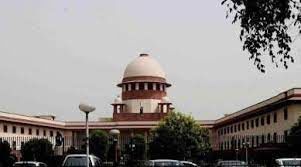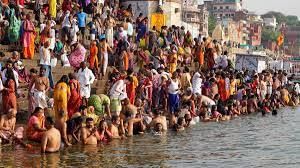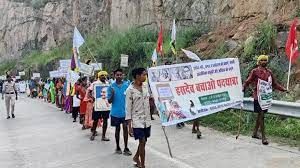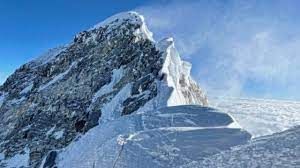UPSC Daily Current Affairs- 24th April 2023 | Current Affairs & Hindu Analysis: Daily, Weekly & Monthly PDF Download
GS-I
Pushkaralu Festival returns to the Ganga after 12 years
Why in News?
The 12-day Pushkaralu festival of Telugu-speaking people began on April 22 in Varanasi.
Pushkaralu Festival
- Pushkaram is an Indian festival dedicated to worshiping of 12 sacred rivers.
- The celebration happens annually, once in 12 years along each river.
- Each river is associated with a zodiac sign, and the river for each year’s festival is based on which sign Bruhaspathi (Jupiter) was in at the time.
- It is believed that bathing in the sacred river during Pushkaram cleanses the devotees of their sins.
- This year festival involves worshipping ancestors and the river Ganga and is being organised in Kashi after a gap of 12 years.
Why is it celebrated once in 12 years?
- In India, we have 12 major rivers such as Ganga, Yamuna, Narmada, Saraswathi, Godavari, Krishna, Kaveri, Bhima, Tapati, Tungabhadra, Sindhu, Pranhita for which the Pushkaram festival is celebrated for each river according to the zodiac sign of that river.
- The 12 days after the Jupiter enters that particular zodiac sign will be the Pushkaram/Pushkaralu which is a 12-day festival for that river.
- Hence Pushkaralu comes for every 12 years.
Legend of the Festival
- According to legend, after severe penance, the devotee Pushkara was blessed by Lord Shiva with the ability to live in water and purify holy rivers
- On a request from Bruhaspati (Jupiter), Pushkara decided to enter one of the 12 sacred rivers, including Ganga, Yamuna, Godavari, and Krishna, among others
- The river for each year’s festival is decided in accordance with Brihaspati travel from one zodiac sign to another
Source: The Hindu
Protests in Chhattisgarh Over Coal Mining
Why in News?
Recently, the Adani Enterprises Limited (AEL) coal mining project in Chhattisgarh has sparked a controversy due to its impact on the environment and local communities.
- AEL has been mining coal in the Parsa East and Kente Basan coal blocks of Chhattisgarh's Surguja district for over a decade now.
- For more than a year now, locals, largely from the Gond tribe, in Hariharpur, Ghatbarra, and Fattepur villages of Chhattisgarh, have been holding a sit-in at the entrance to Hariharpur against mining.
What are the Impacts of the Mining Operations?
- Impact on the Environment:
- Mining in the region will lead to the loss of about 8 lakh trees of the Sal forests in Hasdeo Aranya. This will end up affecting the catchment of the Hasdeo river.
- Around the time that mining was beginning, there had been an attempt to save the trees. The National Green Tribunal (NGT), in 2014, stayed the mining licenses, ordering studies on the environmental impact of the mines. However, the Supreme Court set the NGT order aside, and mining began.
- Impact on Locals:
- The mining project has adversely affected the lives of locals. As the mine has consumed forest land.
- 'Save Hasdeo Campaign' is also being run to save the forests of Hasdeo.
- The mines have destroyed grazing land for cattle, affected the groundwater level, and the blasting has loosened the earth around borewells, and tube wells people had been using for minor farming.
- The stream next to Hariharpur, once used to have water and fish throughout the year, has turned into a muddy stream since the digging has affected the catchment area.
What is Coal?
- About:
- It is a type of fossil fuel found in the form of sedimentary rocks and is often known as 'Black Gold'.
- It is a conventional source of energy and is widely available. It is used as a domestic fuel, in industries such as iron and steel, steam engines and to generate electricity. Electricity from coal is called thermal power.
- The leading coal producers of the world include China, US, Australia, Indonesia, India.
- Distribution of Coal in India:
- Gondwana Coal Fields (250 million years old):
- Gondwana coal makes up to 98% of the total reserves and 99 % of the production of coal in India.
- It forms India’s metallurgical grade as well as superior quality coal and has a high ash content.
- It is found in Damodar (Jharkhand-West Bengal), Mahanadi (Chhattisgarh-Odisha), Godavari (Maharashtra), and Narmada valleys.
- Tertiary Coal Fields (15 – 60 million years old):
- Carbon content is very low but is rich in moisture and sulphur.
- Tertiary coalfields are mainly confined to extra-peninsular regions.
- Important areas include Assam, Meghalaya, Nagaland, Arunachal Pradesh, Jammu and Kashmir, Himalayan foothills of Darjeeling in West Bengal, Rajasthan, Uttar Pradesh, and Kerala.
- Classification:
- Anthracite (80 - 95% carbon content, found in small quantities in J&K).
- Bituminous (60 - 80% carbon content and is found in Jharkhand, West Bengal, Odisha, Chhattisgarh and Madhya Pradesh).
- Lignite (40 to 55% carbon content, high moisture content and is found in Rajasthan, Lakhimpur (Assam) and Tamil Nadu).
- Peat (less than 40% carbon content and it is in the first stage of transformation from organic matter (wood) to coal).
- Coal Reserves:
- Top States in terms of total coal reserves in India are Jharkhand, Odisha, Chhattisgarh, West Bengal, and Madhya Pradesh.
- Gondwana Coal Fields (250 million years old):
Source: The Hindu
GS-II
50 years of Kesavananda Bharati Case

Why in News?
Fifty years ago, on April 24, 1973, the Supreme Court delivered its judgment in Kesavananda Bharati Sripadagalvaru and Ors vs. State of Kerala and Anr, the landmark case that redefined the relationship between Parliament and the Constitution.
Kesavananda Bharati Case (1973)
- The Kesavananda Bharati judgement, was a landmark decision of the Supreme Court that outlined the basic structure doctrine of the Indian Constitution.
- The case is also known as the Fundamental Rights Case.
- The SC in a 7-6 decision asserted its right to strike down amendments to the constitution that were in violation of the fundamental architecture of the constitution.
- The Court asserted through the Basic Structure doctrine that the constitution possesses a basic structure of constitutional principles and values.
Key outcomes were:
- Basic Structure Doctrine: It is a principle that limits Parliament’s power to amend the Indian Constitution. It holds that certain fundamental features of the Constitution, such as the principle of separation of powers, cannot be amended by Parliament.
- Judicial Review: The Court partially cemented the prior precedent Golaknath v. State of Punjab, which held that constitutional amendments through Article 368 were subject to fundamental rights review, but only if they could affect the ‘basic structure of the Constitution’.
- Exceptions to Judicial Review: At the same time, the Court also upheld the constitutionality of the first provision of Article 31-C, which implied that amendments seeking to implement the Directive Principles, which do not affect the ‘Basic Structure,’ shall not be subjected to judicial review.
Criticism of the doctrine
- Dilution of powers: The basic structure doctrine has been criticized for diluting the principle of separation of powers and undermining the sovereignty of Parliament.
- Ambiguous nature: It has also been criticized as a vague and subjective form of judicial review.
Landmark cases of the doctrine
- Indira Gandhi v Raj Narain (1975): The Supreme Court applied the principle laid down in the Kesavananda ruling for the first time in this case. It struck down The Constitution (39th Amendment) Act, 1975, which barred the Supreme Court from hearing a challenge to the election of President, Prime Minister, Vice-President, and Speaker of Lok Sabha.
- Minerva Mills Ltd vs. Union of India (1980): The Supreme Court struck down a clause inserted in Article 368, which said “there shall be no limitation whatever on the constituent power of Parliament to amend by way of addition, variation or repeal the provisions of this Constitution.”
- P Sambamurthy v State of Andhra Pradesh (1986): The Supreme Court struck down a portion of the 32nd Amendment (1973), which constituted an Administrative Tribunal for Andhra Pradesh for service matters, taking away the P jurisdiction of the High Court.
- L Chandra Kumar v Union of India (1997): The Supreme Court struck down a portion of the 42nd Amendment, which set up administrative tribunals excluding judicial review by High Courts.
Significance of the Judgment and the doctrine
- Strengthen judicial review: The doctrine forms the basis of the power of the Indian judiciary to review and override amendments to the Constitution of India enacted by the Parliament.
- Clarification about Article 368: Article 368 postulates only a ‘procedure’ for amendment of the Constitution. The same could not be treated as a ‘power’ vested in the Parliament to amend the Constitution to alter the ‘core’ of the Constitution, which has also been described as the ‘basic structure’ of the Constitution.
- Not antithetical to legislative authority: Justice Shastri said Judicial Review was undertaken by the courts “not out of any desire to tilt at legislative authority in a crusader’s spirit, but in the discharge of a duty laid down upon them by the Constitution”.
- A system of checks and balances: The Kesavananda Bharati verdict (1973) made it clear that judicial review is not a means to usurp parliamentary sovereignty. It is a “system of checks and balances” to ensure constitutional functionaries do not exceed their limits.
Source: Indian Express
Screening Test for Heart Ailments
Why in News?
Recently, some experts have suggested the Large-Scale Screening Tests to prevent Heart Ailments.
What is the Screening Test?
- About:
- The main purpose of screening or early detection is to pick up people with probable disease and confirm it with another test.
- Screening tests are usually cheap and easy to operate on a large-scale while confirmatory tests are resource intensive.
- The goal of mass screening is to detect heart diseases in their early stages, before symptoms appear, so that preventive measures can be taken to reduce the risk of future heart attacks or sudden cardiac death.
- The screening tests for heart ailments include Blood Pressure measurement, cholesterol and lipid profile test, ECG (Electrocardiogram), etc.
- These tests can help identify the risk of heart disease, irregular heart rhythms, abnormalities in the heart's structure or function.
- Need:
- The need for screening tests for heart ailments is to detect any underlying risk factors or signs of heart disease before it becomes life-threatening.
- Sudden blockages of the artery supplying the heart can lead to a heart attack, which can be fatal.
- Screening tests can help identify risk factors such as high blood pressure, high cholesterol levels, or irregular heart rhythms, which can be managed with lifestyle changes, medication, or other interventions before they develop into more severe forms of heart disease.
What are the Challenges Related to Screening at Mass Level?
- Risk of Procedure or False Labeling:
- The risks associated with screening tests include both the risk of procedure (how tests are performed) as well as false labeling.
- For instance, stress ECG when used as a screening test in young asymptomatic patients gives many false positives.
- This results in unnecessary anxiety and more unwarranted tests to confirm or reject its findings.
- Additional Risk and Costs:
- Tests like stress echocardiography/radionuclide test and CT angiography can accurately detect blockages and people with higher risk for cardiac events as compared to ECG. But there may also be associated risks related to false results, leading to unnecessary test and additional Costs.
- A Danish study published in 2022 showed that a population well-treated for risk factors for heart disease derived no benefit from additional tests, including CT scans.
- Lack of Access to Tests:
- In India, a significant portion of the population (about 25-30%) is above 40 years old. However, most district hospitals and some medical colleges in India do not have access to imaging tests such as stress echocardiography, radionuclide tests, and CT angiography.
- Moreover, these tests are relatively expensive, ranging from Rs 6,000 to Rs 15,000 in the public or private sector.
- It is crucial to take into account the accessibility of these tests for the public and whether our healthcare infrastructure is capable of handling individuals who receive a positive test result.
Way Forward
- Using modern medical tools such as stress echocardiography, radionuclide tests, and CT angiography should be limited to a smaller set of people who are at higher risk of ischemic heart disease.
- High-risk individuals can be identified by screening for known risk factors such as tobacco use, obesity, hypertension, diabetes, hypercholesterolemia, and family history of early heart disease.
- However, the most important approach for preventing cardiac deaths is to promote healthy habits among populations of all ages.
- Simple tests for known risk factors are cheap, widely available, and can be conducted during standard executive checkups at district hospitals.
Source: The Hindu
GS-III
Microbes found near Mt. Everest
Why in News?
Researchers conducted a genetic analysis of microbial communities on the South Col of Sagarmatha (Mount Everest).
- The article examines the human microbiota on the inhospitable slopes of Mount Everest esp. the South Col ridge.
Microbial Communities on the South Col
- Microbial communities were collected from sediment samples left by human climbers on the South Col, 7,900 meters above sea level (msl).
- The South Col is inhospitable due to low oxygen, strong winds, high levels of UV radiation, and temperatures below minus 15 degrees Celsius.
- Visible signs of life are absent above 6,700 msl except for a few species of moss and a jumping spider.
- Microbes are carried to high altitudes by birds, animals, winds, and dust particles.
Microbes found
- Using sophisticated methods such as 16S and 18S rRNA sequencing, the microbe hunters were able to identify the bacteria and other microorganisms found on the South Col.
- 16s rRNA is a component of the 30S subunit in prokaryotic ribosomes while 18s rRNA is a component of the 40S subunit in eukaryotic ribosomes.
- 16S ribosomal RNA (rRNA) sequencing is an amplicon sequencing technique used to identify and compare species of bacteria present within a given sample.
- 16S rRNA gene sequencing is used to study phylogeny and taxonomy of samples from complex microbiomes or environments that are difficult or impossible to study.
- Microbes like Modestobacter altitudinis and the fungus, naganishia, which are known to be UV-resistant survivors are found there.
History of Mount Everest and Naming
- Nepal’s eminent historian, late Baburam Acharya, gave the Nepali name Sagarmatha to Mount Everest in the 1960s.
- Andrew Waugh, British Surveyor General of India, discovered Mount Everest in 1847 and named it after his predecessor, Sir George Everest.
- Radhanath Sikdar, an Indian mathematician and surveyor, was the first person to show that Mount Everest was the world’s highest peak in 1852, with the help of a special device.
Source: The Hindu
Translocation of Elephants

Why in News?
The Supreme Court recently dismissed the Kerala government's appeal against the order of the Kerala HC directing the relocation of Arikomban (Wild Elephant), the "rice tusker" of Munnar, to the Parambikulam tiger reserve.
What are the Arguments in Favour of Elephant Translocation?
- The Kerala High Court highlighted that the availability of natural food and water resources in the relocation site would deter the elephant from foraging in human settlements.
- The court also emphasised that the elephant will be radio-collared, and its movements monitored by forest/wildlife officials, which would effectively remove the surprise element of any conflict situation.
What are the Arguments Against Elephant Translocation?
- India’s first radio-telemetry study of a translocated problem elephant was conducted in 2006 on a large male shifted from the cropland of West Midnapore in South Bengal to the Mahananda Sanctuary in Darjeeling district.
- Almost immediately, the elephant started damaging houses and raiding crops in villages and Army areas.
- A study on translocated problem Asian elephants was conducted in 2012, in which a team of biologists monitored 12 male elephants translocated 16 times to different national parks in Sri Lanka.
- The study found: Translocation caused wider propagation and intensification of human-elephant conflict, and increased elephant mortality.
- Vinayaga, a bull that gained notoriety as a crop raider, was translocated from Coimbatore to the Mudumalai-Bandipur landscape in December 2018.
- It soon started using gaps in the elephant-proof trench to raid crops, until he was driven back.
Way Forward
- Relocation Impact Assessment:
- It is important to carefully consider the specific circumstances and characteristics of each problem elephant and its potential relocation site.
- Thorough research and analysis should be conducted to assess the availability of natural food and water resources, habitat suitability, and potential risks and challenges of translocation.
- Monitoring and Management:
- Proper monitoring and management plans should also be in place, including post-relocation monitoring and measures to mitigate any potential conflicts.
- While translocation of problem elephants may be considered as a strategy to mitigate human-elephant conflicts, it should be approached with caution and based on sound scientific research, community engagement, and comprehensive management plans to minimise potential risks and ensure the well-being of both elephants and local communities.
- Alternative to Translocation of Elephants:
- Capturing and transforming wild elephants with the help of 'kunkis'(a trained elephant used to capture wild ones) presents a promising approach for translocation.
- This method can offer several benefits, including increased safety during capture operations, reduced stress on translocated elephants due to familiarization with trained 'kunkis', and improved success rates of translocation efforts.
Source: Indian Express
Jal Shakti Ministry plans network of Groundwater Sensors
Why in News?
What is Groundwater?The Jal Shakti Ministry is working on an ambitious plan to deploy a vast network of groundwater sensors to continuously relay information on groundwater levels and contamination.
- Groundwater is the water found underground in the cracks and spaces in soil, sand and rock.
- It is stored in and moves slowly through geologic formations of soil, sand and rocks called aquifers.
- Aquifers are typically made up of gravel, sand, sandstone, or fractured rock, like limestone.
- Water can move through these materials because they have large connected spaces that make them permeable.
- Aquifers, hand-dug wells, and artesian wells are different types of sources of groundwater.
- Under this new initiative, around 16,000-17,000 digital water level recorders will be connected to piezometers in the wells to transmit information digitally.
- In the next three years, the CGWB aims to increase its network from the existing 26,000 to about 40,000.
- When combined with similar networks possessed by other institutions, India will have about 67,000 digitally recordable units to monitor groundwater dynamics.
- This would make groundwater visible much the same way as air quality and meteorological variables
- The information will be publicly accessible.
- It will potentially provide groundwater forecasts to farmers that would be useful for sowing and updated advisories that can influence groundwater extraction policies by states
- Nitrate contamination – a result of the use of nitrogenous fertilizers – has been observed in some regions
- Groundwater contamination, mostly “geogenic” (natural), hasn’t significantly changed over the years.
- But nitrate contamination and fluoride and arsenic contamination have been observed in some regions and states.
- The Central Groundwater Board currently relies on a network of about 26 thousand groundwater observation wells.
- It requires technicians to manually measure the state of groundwater in a region.
- The total annual groundwater recharge in the country has been assessed as 437.60 billion cubic meters (BCM)
- The annual extractable groundwater resource has been assessed as 398.08 bcm, with actual extraction of 239.16 bcm
- The average stage of groundwater extraction for the country as a whole works out to be about 60.08%, and anything above 70% is considered “critical”
Source: The Hindu
|
38 videos|5293 docs|1118 tests
|





















